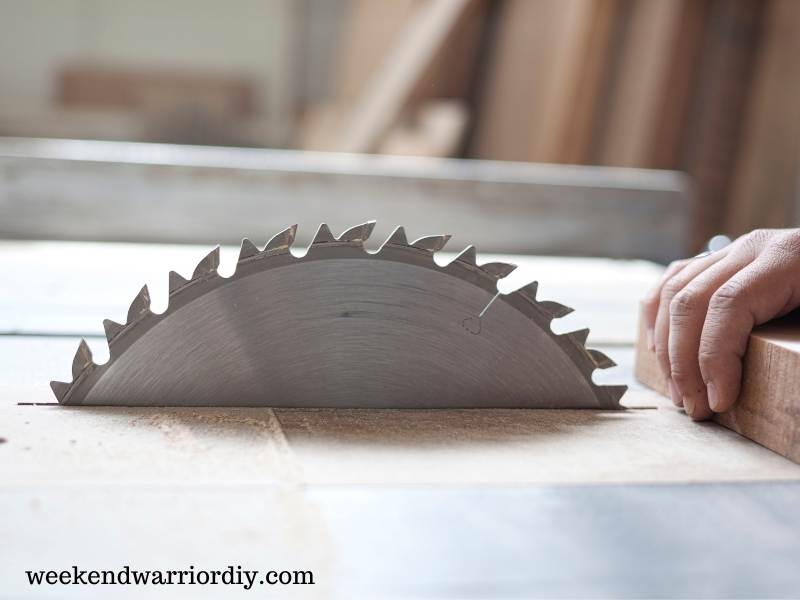For hundreds of years, humans have been doing some form of woodworking without a table saw. In fact, table saws weren’t invented until 1777. Think of all the architecture, boats, furniture, etc. that were masterfully created without the use of a table saw in the past! But can you do woodworking without a table saw today? The answer is…
Yes, woodworking can be done without a table saw. There are many other non-powered and powered tools that can be used in place of a table saw. There are some cuts where a table saw would be the preferred tool of choice however, with a bit of ingenuity, you can get away without owning a table saw and creating some incredible woodworking pieces.
Nowadays, when I hear someone ask if you can do woodworking without a table saw, I immediately assume they aren’t working in the trades and are wanting to do some woodworking at home. They might not have the funds nor the space for such a large piece of equipment. You can spend a fair amount of money on a new table saw so you need adequate space to operate it both properly safely.
So, if you’re ready to learn more about woodworking sans table saw, then let’s begin!
What Can You Use if You Don’t Have a Table Saw?
There are many power and manual tools you can use for specific cuts without a table saw. Most of the time, it’s just sitting back and thinking about the cut you need done and what your options are.
The best way to determine which tools can replace your table saw is to look at the cuts you would perform on one and suggest alternative ways to achieve them. There are 3 main cuts that we’ll look at – ripping, crosscutting and dado cuts.

Ripping Without a Table Saw
Ripping is when you cut with the grain. This cut is typically done by cutting with the length of the piece of wood or plywood which is how the grain usually runs. Depending on the length and size of the wood, you have different options.
Let’s talk first about a sheet of plywood. Even though a handsaw is quite capable of cutting the length of a sheet of plywood, it wouldn’t be as easy as using a power tool. I don’t recommend using a handsaw for ripping down a sheet of plywood.
I do however, recommend using a circular saw with a guide to rip plywood. It’s very easy to make a terrible cut when trying to use a circular saw to rip a sheet of plywood. With the help of a circular saw guide, you can have just as clean a cut as you would using a large shop table saw with a runoff table.
If you’re looking for a circular saw guide, make sure to check this one out on Amazon.
The only other power tool I’d consider using to rip a sheet of plywood is a jigsaw. It’s not ideal but with the help of a guide, you could make a fine-looking cut using a jigsaw as well.
If you’re ripping a smaller piece of wood or even a shorter piece of plywood, you could use a bandsaw if you have one or a jigsaw would be fine for shorter pieces. A handsaw is also an option.
If the piece of wood is 12” or less, you can even use a miter saw to rip the wood. I would caution you however, on ripping wood using a miter saw. If you’re not an experienced wood worker, it can be very dangerous using a miter saw in this way. Always think of safety first.
Crosscutting Without a Table Saw
Crosscutting is probably the most common type of cut you’ll make in woodworking. You have many different options that can all make perfectly straight cuts in this manner.
If you’re cross cutting plywood, I’d again recommend using a circular saw with a guide. Cross cutting a 4’ section of plywood will be much easier than running the length at 8’ for ripping cuts.
Depending on the size of wood needing to be crosscut, you have many more options. My miter saw is my go-to for the majority of crosscuts however, I do use a bandsaw, jigsaw and handsaw depending on what I am cutting.

Dado Cuts Without a Table Saw
Dado cuts are usually made by putting a dado blade on a table saw. However, I have been noticing a trend over the last couple of years where woodworkers are using routers to make dado cuts.
If you’re building shelving or cabinets or whatever you are making that needs a squared out cut made in wood, then consider using a router.
If you’ll be performing the same dado-type cut with a router multiple times, then it might be worth your while making a jig. If you don’t make a jig, then setting up some sort of guide for your router to run along will be necessary – assuming you want straight cuts.
Angled Cuts (Bevel/Miter) Without a Table Saw
If all cuts in woodworking were straight and 90 degrees, how boring would that be? You just can’t get away with cutting bevels in woodworking. A table saw works great for these angled cuts but so do many other tools.
If it’s just cutting a 45-degree angle on the side of a 1×6 or similar, then using a circular saw will work fine. You could also make this cut on a bandsaw by tilting the table.
A router can make bevel cuts depending on the bit you use. I have been experimenting with my router lately and new bits and it’s amazing at how many different types of cuts you can actually make with it.
If you have a compound miter saw, you can make bevel cuts with it. You might want to clamp the wood down, especially if it is a smaller piece.
Conclusion
To wrap things up, I want to reiterate which tools are best for cutting wood without a table saw and to say this – a table saw is not a necessary tool for a woodworking workshop. If you’re woodworking in your basement or garage, you can get away without using one. They’re useful and do make life a bit easier in this hobby however, they are not a must-have.
Tools to use in place of a table saw are circular saws, handsaws, jigsaws, routers, band saws and miter saws. When using tools freehand like a circular saw, jigsaw or router, you should use jigs and guides. They’ll be necessary if you want straight, accurate cuts.
I hope you’ve found this article helpful. Thanks for reading and good luck with your next woodworking project!
Related Posts
Woodworking When You Live in an Apartment (How to Do it Right)!
Should You Buy a Trim Router or Plunge Router? A Comprehensive Guide
Unlocking the Potential of Drum Sanders: A Woodworker’s Secret



